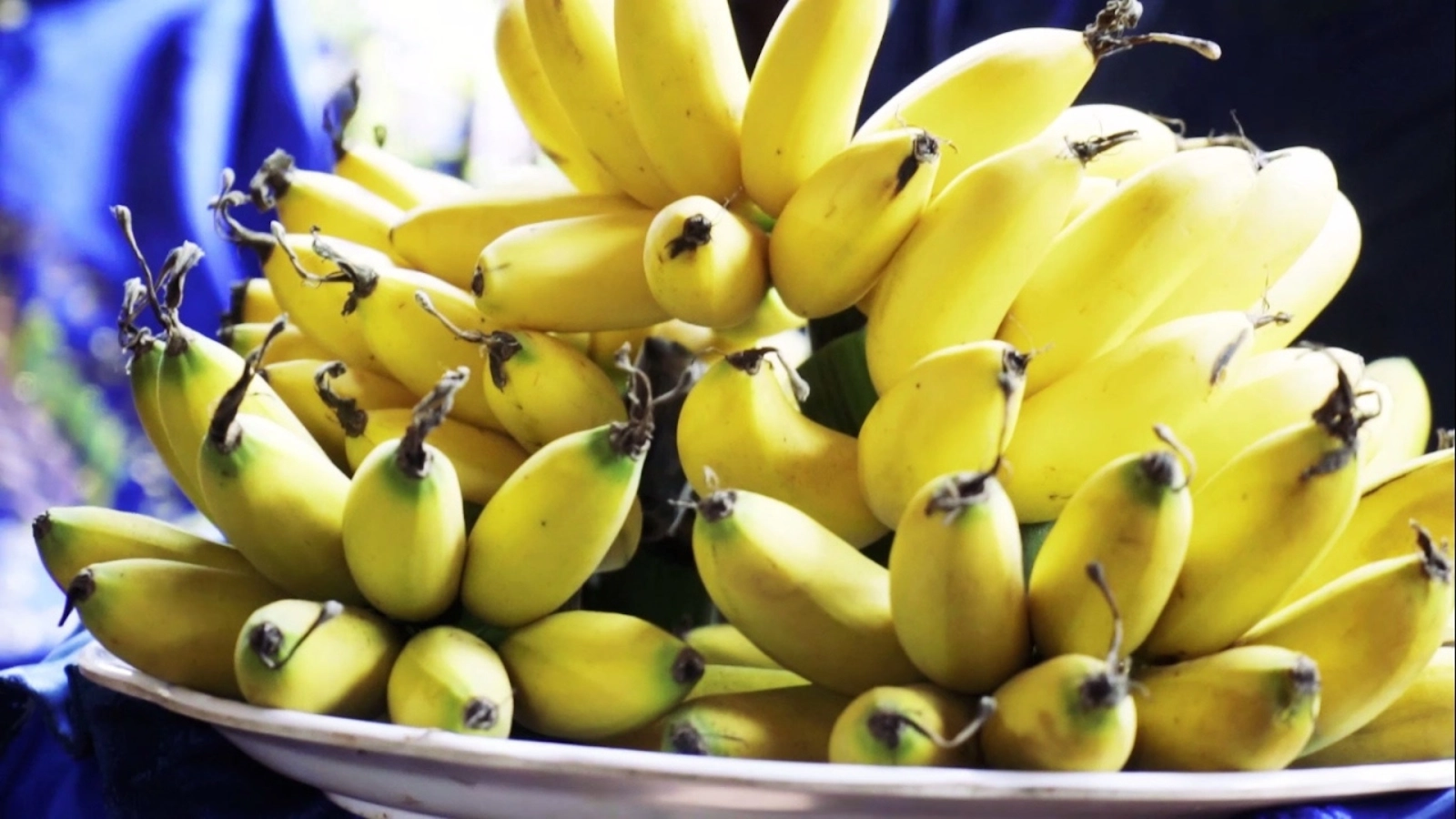1. Introduction to Dai Hoang Ngu banana
1.1. Origin and development journey of Dai Hoang Ngu banana

Dai Hoang Royal Banana - a "king's tribute" specialty not to be missed. (Source: Collected)
The story of the royal banana has been associated with Dai Hoang village since the Tran Dynasty. Legend has it that during a royal tour to the South, King Tran and his entourage stopped at Ly Nhan prefecture. Here, a simple farming couple offered the king bunches of golden bananas. Upon tasting, King Tran was immediately captivated by the distinct, delicate sweetness and immediately decreed this banana to be a tribute for the royal court. Since then, Dai Hoang royal bananas have carried the image of royal authority, becoming a symbol of luxury and preserved in folk life.
The tradition of offering bananas to the court not only existed under the Tran Dynasty but was also maintained through later dynasties such as the Later Le, even extending to the Nguyen era. When the capital was located in Hue, Dai Hoang royal bananas were still considered a precious product, requiring packhorses for long-distance transport to be presented to the court on time, further affirming the special status of this fruit in aristocratic life.
Through many historical changes, Dai Hoang royal bananas still endure as the pride of the local people. From generation to generation, they have persistently preserved this precious banana variety on suitable lands along the river, maintaining its original flavor and identity.

Dai Hoang royal bananas have a unique, incomparable flavor. (Source: Collected)
Entering the modern era, the story of preserving royal bananas has been elevated by scientific and community efforts: establishing nurseries to ensure genetic resources, organizing fairs and festivals to promote specialty products, while expanding consumption markets. Clean agriculture research is also applied aiming to both improve quality and increase output, ensuring Dai Hoang royal bananas retain their "unique essence" amidst the era of overwhelming industrial agricultural products.
Today, royal bananas are not just a renowned fruit, but also cultural "ambassadors", linked to community tourism development and sustainable economic models. Each bunch of bananas sold not only carries economic value but also serves as a testament to the pride of a long-standing craft village, where people both preserve heritage and write new stories to bring Dai Hoang royal bananas further afield.
1.2. Protection of geographical indications and location for growing specialty products
The year 2009 is an important milestone when Dai Hoang royal bananas received Geographical Indication, officially affirming the position of this product in Vietnam's agriculture sector. Nam Ly Commune (Ninh Binh), with a focus on the alluvial plain area along the Chau Giang River, is the main protected growing area.
This geographical advantage has created excellent natural conditions for banana cultivation. Fertile alluvial soil, freshwater sources, and the region's year-round mild climate have nurtured Dai Hoang royal bananas with a unique, incomparable mark. The Dai Hoang Royal Banana Production and Consumption Association was established to preserve, connect farmers with the market, and affirm brand value.
1.3. Reasons why Dai Hoang royal bananas have become a prominent specialty in Ninh Binh
Dai Hoang royal bananas have long transcended the concept of an ordinary fruit to become a culinary symbol deeply imprinted with the culture of the ancient capital region. With their small, delicate shape, shiny golden peel, and a sweet, refreshing flavor that is easy to enjoy, royal bananas often appear in reunion feasts, at rural festivals, and especially solemnly on the ancestral altar during the Lunar New Year as a token of gratitude and connection between generations.
More than just food, Dai Hoang royal bananas today have also become meaningful gifts, carrying deep spiritual value. Tourists visiting Ninh Binh often look to buy bunches of royal bananas to bring back as souvenirs, as a way to preserve the flavors of the Vietnamese countryside and the sophistication of traditional agriculture. The image of golden bunches of bananas carefully placed in gift baskets also reflects cultural exchange, appreciation, and pride in local products.

Dai Hoang royal banana has high cultural value. (Source: Collected)
Through festivals, cultural events, and community tourism trips, Dai Hoang royal banana is becoming increasingly well-known, not only captivating tourists but also attracting the interest of investors who love local agricultural products. Thanks to this, banana growers have an additional stable income source, contributing to building a sustainable agricultural economic model where the value of the homeland's heritage is both preserved and spread everywhere.
2. Identifying characteristics of Dai Hoang royal banana
2.1. Shape, size, and special color of Dai Hoang royal banana
The first thing that captivates tourists when admiring Dai Hoang royal banana is the elegant and luxurious beauty of each bunch of bananas. The banana fruit is small, only about 8–10 cm long with a diameter of 1.5–2 cm, perfectly sized to fit snugly in the palm of the hand. The thin, smooth peel is like paper, shimmering with a brilliant yellow hue and taut and glossy as if coated with a layer of shimmering honey, making the royal banana a standout highlight among countless other fruits.
When peeled, the banana flesh appears moderately chewy, with plump, rounded tips, adorned with characteristic small tendrils – this detail is considered the 'identification mark' of genuine royal bananas. Just bringing it close, its gentle, naturally refreshing aroma has already spread, evoking a sense of familiarity yet sophistication. Taking a bite, a delicate sweetness spreads across the tongue, leaving a lingering mild sweetness, never harsh or cloying.

The Dai Hoang royal banana has a shiny, vibrant golden peel. (Source: Collected)
The harmonious combination of attractive appearance, pure aroma, and delicate sweetness has created an irresistible charm, making the Dai Hoang royal banana not just a fruit to enjoy, but also a source of pride for the land of Ninh Binh, a specialty strong enough to captivate anyone who has ever tasted it.
2.2. Structure of Bunches, Hands, and Leaves
The **Dai Hoang royal banana** tree is usually about 2.6 m tall, with a slender trunk, and about 31 upright leaves growing on the trunk in a slightly tilted manner. The leaf stalks are tightly joined, forming a sturdy pseudostem, suitable for windy alluvial plains.
The banana bunch is usually quite short and round, measuring 45–100 cm in length depending on growth conditions. One bunch has about 5–8 hands, each hand arranged with 12–15 fruits evenly. When the banana starts to flower, the color of the bunch gradually changes from green to light yellow, signaling that harvest time is approaching.
In each banana clump, usually only one mother plant and two suckers are kept to ensure the quality of the fruit bunch and preserve the variety. The leaves of the **Dai Hoang royal banana** are slender, long, and slightly tilted to one side, contributing to the characteristic beauty of this plant species.
2.3. Traditional Cultivation Methods and the Role of Growers
What makes the distinct quality of the **Dai Hoang royal banana** lies not only in the rare variety but also in the traditional cultivation methods preserved by the people through generations. This type of banana only truly grows healthily on fertile alluvial plains along the Chau Giang river, where the soil is loose and particularly rich in natural trace elements, which are hard to find in other regions.

The people of Dai Hoang village preserve and pass down the 'royal' banana cultivation method. (Source: Collected)
Banana growers here still maintain organic farming practices, minimizing chemical fertilizers to preserve the original flavor. A small amount of nitrogen fertilizer is applied moderately at the beginning of the season, strictly avoiding fresh manure so that the ripe fruit retains its characteristic delicate sweetness.
From cultivation to harvest, meticulous care is required. Ripe banana bunches are gently lowered to avoid bruising, then cured using rice husks or kitchen ash according to traditional methods. This natural curing process helps the bananas turn honey-yellow, ripen evenly, and become fragrant without any supporting chemicals. Even the technique of propping up fruit-laden bunches is a small but important secret to prevent the trees from breaking, ensuring the fruits remain plump and of the best quality.
All these stages, from the unique alluvial soil to the skillful hands and patience of the growers, have created Dai Hoang royal bananas – a fruit that is not only a specialty of the ancient capital region but also the crystallization of a long-standing agricultural cultivation heritage.
3. Nutritional Value of Dai Hoang Royal Bananas
Dai Hoang royal bananas are not only famous for their delicate sweetness and chewy fragrance but are also known as 'small but mighty' fruits due to their outstanding nutritional content. The small, golden bananas, each weighing only about 80–90 kcal, are rich in vitamins and minerals, allowing visitors to enjoy a delicious treat while being assured of its health benefits.
On tours to Ninh Binh, many tourists enjoy choosing royal bananas as souvenirs. The mild, delicate sweetness and lingering aftertaste of royal bananas are likened by many to the 'taste of Tet' – because, on the reunion feasts of spring days, a golden bunch of royal bananas always holds a place of honor.

Dai Hoang royal banana is very rich in nutritional value. (Source: Collected)
Besides that, Dai Hoang royal banana is also considered a luxurious yet simple gift, suitable for both relatives and partners. The way to preserve the banana is also quite simple – just keep it in a dry, cool place, choose fruits with fresh yellow skin and green stems to preserve the natural flavor.
Nowadays, royal banana not only appears in the culinary life of local people but also contributes to promoting the image of Ninh Binh land to friends at home and abroad. Thanks to the combination of nutritional value, characteristic flavor, and cultural significance, Dai Hoang royal banana has become a typical tourist specialty, making anyone who has tasted it want to bring back a bit of hometown flavor.
4. Popular types of Dai Hoang royal banana

Dai Hoang Ngu banana has a gentle aroma. (Source: Collected)
4.1. White Ngu banana
White Ngu banana is the most popular variety, highly favored for its mild and easy-to-eat flavor. When ripe, the peel turns a light yellow, the fruits are small and uniform, with a characteristic refreshing sweet taste. The main harvest time is late spring to early summer, when the weather helps enhance sweetness.
The flesh of the White Ngu banana is ivory white, smooth, chewy, and gently fragrant. This is a reasonable choice for gifts during holidays or as a dessert after family meals.
4.2. Buffalo Ngu banana
Compared to the white variety, the Buffalo Ngu banana is slightly larger, with a thicker peel that makes transportation easier. The aroma retains the unique characteristic of Ngu bananas but is milder. When ripe, the peel turns deep yellow, and the flesh is firm and sweet.
The Buffalo Ngu banana is very convenient, suitable for eating fresh as well as being used in traditional dishes like banana cake, sweet soup, or dried bananas. Its ease of preservation and stable sugar content make the Buffalo Ngu banana a choice for many families to stock up on.
4.3. Jackfruit Ngu banana
The Jackfruit Ngu banana is the rarest and most precious variety among Ngu bananas, famous for its strong aroma and unique shape. The fruit is slender, with a thin, deep yellow peel when ripe, while the flesh has a distinctive pale pink hue.
The aroma of the Jackfruit Ngu banana is extremely prominent, easily recognizable from afar. The rich sweetness with a deep aftertaste creates an unforgettable experience for the consumer. Due to its difficulty to cultivate and rarity, this banana variety often has a high market value, making it suitable as a gift for important occasions.
4.4. Other specialty banana varieties in Ninh Binh
Besides Ngu bananas, Ninh Binh also possesses many native banana varieties like common bananas, plantains, and lady finger bananas, contributing to the diversification of fruit products from the ancient capital region. Each type of banana has its own characteristics, meeting the diverse needs of the people.
Nevertheless, Dai Hoang Ngu banana remains the most mentioned name due to its superior quality and value. The blend of flavor, historical significance, and nutrition has created an irreplaceable brand. This is why Ngu bananas are always a preferred choice for tourists wishing to bring back a meaningful gift when visiting Ninh Binh.

Dai Hoang Royal Banana - a precious gift offered to the king. (Source: Collected)
Dai Hoang Royal Banana is not just a fruit, but also a treasure trove of culture and heritage linked to Vietnam's agricultural traditions. Its unique flavor and high nutritional value have made this banana a cherished symbol of Ninh Binh. Come to Dai Hoang to experience and bring back meaningful specialty gifts from this land rich in tradition.








